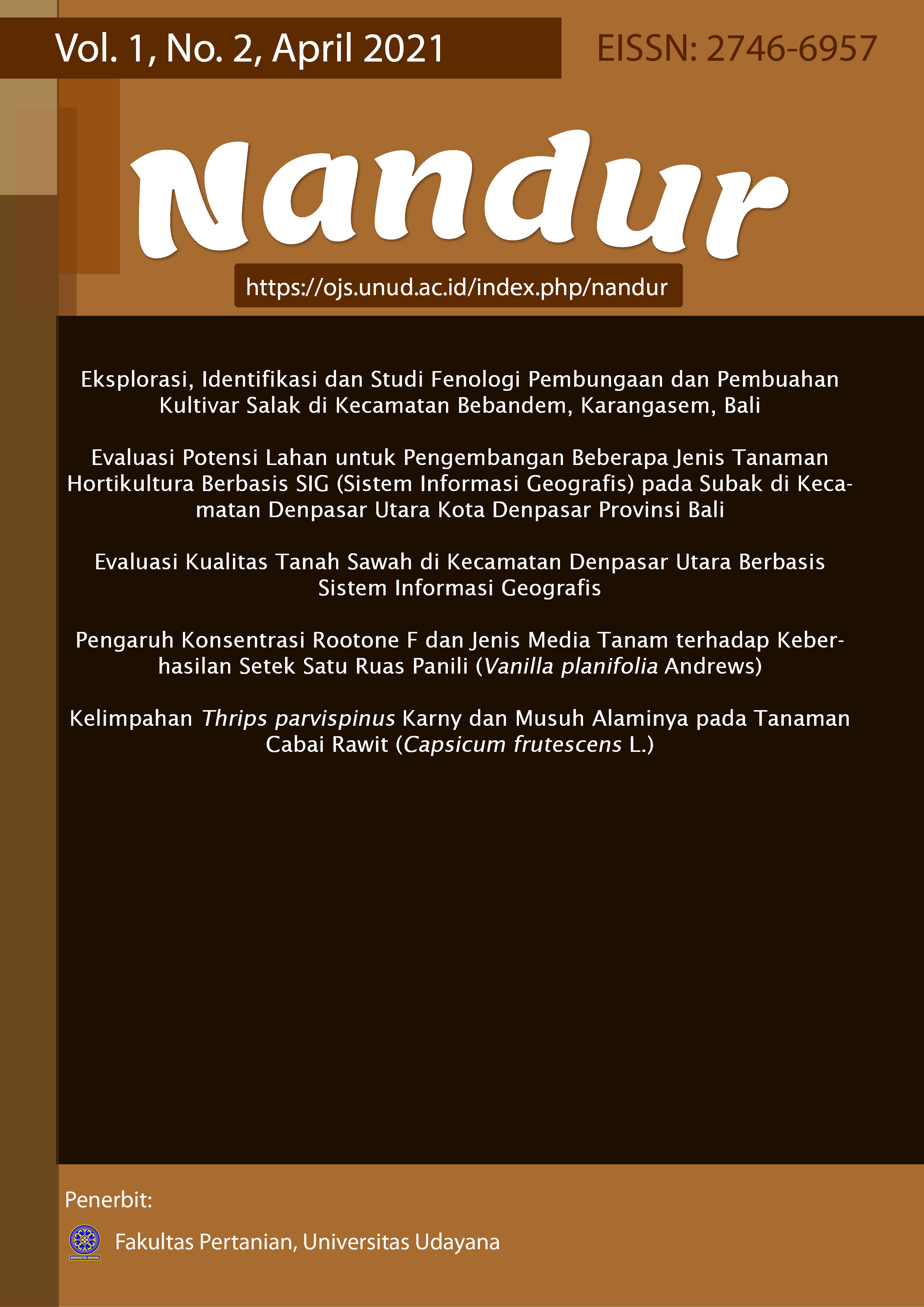Kelimpahan Thrips parvispinus Karny dan Musuh Alaminya pada Tanaman Cabai Rawit (Capsicum frutescens L.)
Abstract
This aims of the research is to search the abudance of T. parvispinus Karny and its natural enemies on Cayenne Pepper (Capsicum frutescens.L). The research started from November 2020 to January 2021 at Melinggih Kelod Village, Payangan District, Gianyar Regency and at the Plant Pest Laboratory, Faculty of Agriculture, Udayana University. The study was conducted using a descriptive method by conducting a diagonal survey of 20 samples of cayenne pepper that were attacked by T. parvispinus. Observations were made by observing 10 leaves and 10 flowers of cayenne pepper plants. The results showed that the abundance of T. parvispinus in the vegetative and generative phases fluctuated where the highest population of T. parvispinus occurred in plants aged 10 week after transplanting with an average population of 15.8 individuals per plant then decreased in plants aged 11 WAT with an average population 9.75 individuals. The results showed that there were two types of predators that preyed on T. parvisvinus, namely Chrysoperla carnea with an average population of 23.3 and Coccinela transversalis with an average of 22.4 individuals. Laboratory reseach showed that the type of parasitoid that emerged from the 100 nymphs that were caught was Ceranisus spp with an average population of 10.2 individuals.
References
Kartohardjono, A. (2011). Penggunaan Musuh Alami Sebagai Komponen Pengendalian Hama Tanaman Padi Berbasis Ekologi. Subang : Balai Besar Penelitian Tanaman Padi. 4:1 29-46
Meilin, A. (2014). Hama dan Penyakit pada Tanaman Cabai Serta Pengendaliannya. Jambi: Balai Pengkajian Teknologi Pertanian Jambi.
Moritz, G., L. A. Mound, D. C. Morris, and A. Goldarazena. (2014). Pest Thrips of the Word. Australia.
Loomans, A. (2003). Parasitoids as Biological Control Agents of Thrips Pests.
Pearsall, I. A., J. H. Myers. (2000). Population Dynamics of Western Flower Thrips (Thysanoptera: Thripidae) in Nectarine Orchards in British Columbia. Journal Economic Entomology 93(2), 494–502.
Purnomo, H. (2010). Pengendalian Hayati. Yogyakarta: C.V Andi Offset. Hal 55-68.
Riudavets, J., C. Castane dan R. Gabarra. (1995). Native Predators of Western Flower Thrips in Horticultural Crops. NATO ASI Series. Series A: Life Sciences. 276: 3-16.
Sari, N., Jasmin & Putri. P. (2013). Kepadatan Populasi Thips sp. (Tysanoptera:Thripidae) Pada Tanaman Cabai Di Kampung Batu Kecamatan Danau Kembar Kabupaten Solok. Program Studi Pendidikan Biologi Sekolah Tinggi Keguruan dan Ilmu Pendidikan Sumatera Barat. Sumatera.
Wagiman, FX. (1997). Ritme Aktivitas Harian Menochilus sexmaculatus Memangsa Aphis cracivora. Kongres Entomologi V dan Simposium Entomologi. Perhimpunan Entomologi Indonesia, Bandung, 24-26 Juni 1997



